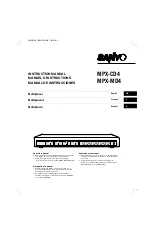
HART Multiplexer Master KFD2-HMM-16
Product description
16
Subject to reasonable modifications due to technical advances.
Copyright Fuchs, Printed in Germany
Fuchs Group • Tel.: Germany (06 21) 7 76-0 • USA (330) 4 25 35 55 • Singapore 7 79 90 91 • Internet http://www.pepperl-fuchs.com
P
a
rt
N
o
.: 1
09143
, D
a
te o
f i
ssue 29
.11.2
000
2.3
System construction
2.3.1
System description
In process engineering plants, there are many field devices distributed over a large area. The characteristic
values of these field devices must be monitored, for example, in the context of ISO 9000 and recorded and
adapted to changes in process parameters.
The HART multiplex system from Fuchs enables online communication between a PC and "smart"
field devices that support the HART protocol.
Smart transmitters and intelligent valve positioners enable information such as measurement range, tag
number, ID number and manufacturer to be stored in the field device itself. Access to these data is usually
obtained using a handheld terminal. This means, that when changes to information are required, connection
to the field device must be carried out "By hand".
When specific data has to be recorded in the context of quality assurance - in accordance with ISO 9000 -
this means that there is an increased demand on the process control system or the DCS. For example, the
data has to be cyclically interrogated and then stored by the system in a database.
The HART multiplex system from Fuchs provides the coupling between the PC and the intelligent
"HART-capable" field devices. All access to the field device takes place in parallel with the transfer of the
4 mA ... 20 mA measuring signal and therefore has no affect on the processing of measured values by the
process control system.
The system thus provides a subordinate service interface. It is also possible to obtain measured values
through the HART multiplex system. On field devices, which are installed in hazardous areas, the coupling
takes place on the safe area side of the current repeaters.
Fuchs can supply the appropriate KFD2-STC4-Ex1/KFD2-STC4-Ex2 smart current repeaters and
KFD2-SCD-Ex1.32, KFD2-SCD-Ex1.LK smart isolated transformers. Similarly, the HART multiplex system
can also be connected to other smart Ex-isolation stages. This means that existing systems can be expan-
ded very easily, thus taking full advantage of the HART communication system.
The system comprises a max. of 31 HART multiplexer masters, which are connected to the PC via a RS 485
interface. Each HART multiplexer master can control up to 15 HART multiplexer slaves. Each multiplexer,
irrespective of master or slave, can connect up to 16 transmitters.
Thus one PC can be used to address up to 7936 field devices for the exchange of data. Operation using a
handheld terminal also remains possible, since the HART protocol accepts 2 masters in one system, i. e.
PC and handheld terminal.
2.3.2
Service station
Besides the control system a PC is frequently used as the service station, with which the parameter
functions or data logging functions can be carried out. Operating programs for the PC are available from
various manufacturers (see section 2.3.3) to provide the necessary back-up for this purpose.
However, in some cases the communication is provided by a process control system via a RS 485 interface
direct (via the HART multiplexer) to the field devices without a connected service station. But the low speed
of the HART communication imposes limitations on this method of operation.
2.3.3
Integration in the operating software (Asset Management Systems)
The full potential of the HART multiplexer System is realised through integration in modern Asset Manage-
ment Systems such as PACTware (open source), SIMATIC PDM (Siemens), AMS (Fisher-Rousemount),
Cornerstone (Applied System Technologies) and Valve Manager (Neles Automation). These operating
tools combine the device functions of the multiplexer in the form of menu commands in a unified interface
providing a very convenient method of operation. The presentation and description of the functions in the
individual operating tools can be very different, however; thus a generally applicable presentation is not
possible here.
Information on the configuration, parameter assignment, operation and diagnostics options of
the multiplexer is provided in the documentation accompanying the various operating tools.
















































